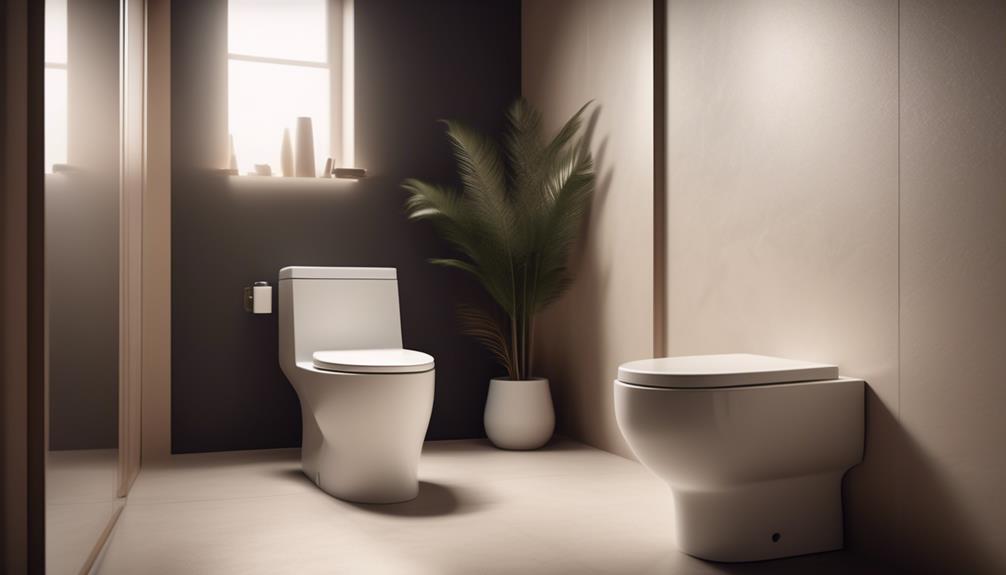When it comes to the weight of a toilet, it may seem like a trivial matter, but it is actually an important consideration for various reasons. Whether you are a homeowner looking to install a new toilet or a contractor tasked with transporting and installing toilets, knowing the weight of a toilet can help you plan and make informed decisions. However, the weight of a toilet is not a one-size-fits-all answer, as it can vary depending on several factors. In this discussion, we will explore the standard weight of a toilet, the factors that can affect its weight, and even delve into lightweight and heavy-duty toilet options. So, if you've ever wondered about the weight of a toilet and why it matters, stay tuned for the answers that await you.
Key Takeaways
- The standard weight of a toilet ranges between 80 and 120 pounds.
- Heavier toilets may require additional reinforcement and support during installation.
- Different types of toilets have varying weight ranges, including lightweight options for outdoor events and camping trips.
- Accurately determining the weight of your toilet is important for transportation, installation, and maintenance purposes.
Standard Toilet Weight

The standard weight of a toilet typically ranges between 80 and 120 pounds, depending on the materials used and the model's size and design. Understanding the weight distribution of a toilet is crucial for a successful installation process. The weight of a toilet is not evenly distributed throughout its structure, and this has significant implications for installation.
When installing a toilet, it is important to consider the weight distribution to ensure stability and prevent any potential damage. The weight of a toilet is concentrated towards the base, especially in the bowl and the tank. This concentration of weight at the base requires proper support to ensure that the toilet remains securely in place.
The impact of toilet weight on the installation process cannot be underestimated. A heavier toilet may require additional reinforcement and support during installation. This can involve using stronger mounting bolts, ensuring that the flange is securely attached to the floor, and using appropriate anchors if necessary.
Furthermore, the weight of a toilet can also affect the type of flooring it can be installed on. For example, lightweight toilets may be suitable for installation on most types of flooring, while heavier toilets may require additional measures, such as reinforced flooring or subflooring.
Factors Affecting Toilet Weight
Various factors contribute to the weight of a toilet, including the materials used, the design features, and additional components. Understanding these factors can help in determining the appropriate toilet weight for installation and maintenance purposes. One important consideration is the distribution of weight within the toilet itself.
The weight distribution within a toilet is crucial for its stability and functionality. A well-designed toilet will have a balanced weight distribution to ensure that it remains stable when in use. This is particularly important for toilets installed in public spaces or areas with high foot traffic. Uneven weight distribution can lead to wobbling or even tipping over, which can be a safety hazard.
Toilet weight can also impact the installation process. Heavier toilets may require additional support during installation to ensure they are properly secured to the floor. This can involve using stronger anchors or reinforcing the subfloor to accommodate the weight. Additionally, the weight of the toilet can affect the ease of transportation and handling during installation.
Toilet weight can vary depending on the materials used and the design features incorporated. The table below provides an overview of the average weight range for different types of toilets:
| Toilet Type | Weight Range (lbs) |
|---|---|
| One-piece | 80-120 |
| Two-piece | 70-100 |
| Wall-mounted | 50-80 |
| Compact | 60-90 |
| Bidet | 50-70 |
It is important to note that these weight ranges are approximate and can vary depending on the specific make and model of the toilet. When purchasing a toilet, it is advisable to consult the manufacturer's specifications for accurate weight information.
Lightweight Toilet Options

To explore lighter alternatives in the world of toilets, we can now focus on lightweight toilet options that provide both functionality and efficiency. These portable toilet options are designed to be easily transported and offer convenience in various situations. Here are some noteworthy options to consider:
- Portable Toilets: Portable toilets are a popular choice for outdoor events, construction sites, and camping trips. These toilets are lightweight and easy to transport, making them ideal for situations where a permanent toilet is not available. They are designed to be compact, durable, and easy to clean, ensuring a hygienic experience for users.
- Composting Toilets: Composting toilets are an eco-friendly option that uses natural processes to decompose waste. They are lightweight and require little to no water for operation. Composting toilets are suitable for both residential and commercial settings and are an excellent choice for those looking to reduce their ecological footprint.
- Low-Flush Toilets: Low-flush toilets are designed to minimize water usage while maintaining performance. These toilets feature a reduced water tank capacity and use innovative flushing mechanisms to ensure efficient waste removal. They are lightweight and can be easily installed in homes or commercial buildings, making them a practical choice for those seeking water conservation.
- Dual-Flush Toilets: Dual-flush toilets provide users with the option to choose between a low-flush and a high-flush mode. This allows for greater water efficiency, as the low-flush option is suitable for liquid waste, while the high-flush option is designed for solid waste. Dual-flush toilets are lightweight, easy to operate, and contribute to water conservation efforts.
These lightweight toilet options offer practical and eco-friendly alternatives for various settings. Whether you need a portable solution or want to minimize water usage, these options provide both functionality and efficiency. Consider these choices when looking for a lightweight toilet that meets your specific needs.
Heavy-duty Toilet Varieties
One notable category of toilet options to explore is heavy-duty varieties, which are specifically designed to withstand high usage and provide long-lasting durability. Commercial grade toilets fall into this category, as they are built to handle the demands of public restrooms, such as those in restaurants, hotels, and office buildings. These heavy-duty toilets are engineered with sturdier materials and reinforced construction to ensure their longevity and reliability.
When it comes to toilet weight and installation requirements, heavy-duty toilets may weigh more than standard residential toilets due to their robust design. The weight of a heavy-duty toilet can vary depending on the specific model and manufacturer, but it generally ranges from 80 to 150 pounds. It is important to consider this weight when planning for installation, as additional support may be required to accommodate the increased load.
Installation requirements for heavy-duty toilets also differ from those of residential toilets. Since they are designed for high usage, they often have more complex plumbing connections and may require professional installation to ensure proper functionality. Additionally, heavy-duty toilets may have specific installation guidelines provided by the manufacturer, which should be followed to ensure optimal performance and longevity.
When selecting a heavy-duty toilet, it is crucial to consider the specific needs and requirements of the intended location. Factors such as water efficiency, accessibility features, and ease of maintenance should also be taken into account to provide the best possible experience for users.
How to Determine the Weight of Your Toilet

When determining the weight of your toilet, it is crucial to accurately assess its specifications in order to ensure proper installation and support. Knowing the weight of your toilet can also help with transportation and handling, especially if you need to move or replace it. To determine the weight of your toilet, follow these steps:
- Use a toilet weight scale: A toilet weight scale is a specialized tool designed to measure the weight of toilets accurately. It provides an easy and convenient way to determine the weight of your toilet without the need for manual calculations.
- Check the manufacturer's specifications: Most toilet manufacturers provide detailed specifications for their products, including the weight. Look for the weight information in the product manual or on the manufacturer's website.
- Calculate the weight of individual components: If you are unable to find the weight information from the manufacturer, you can calculate the weight of individual components and add them up. This includes the weight of the bowl, tank, seat, and any additional features like bidet attachments or flushing mechanisms.
- Consult a professional: If you are unsure about determining the weight of your toilet, it is always a good idea to consult a professional plumber. They have the expertise and knowledge to accurately assess the weight and provide guidance on installation and support requirements.
Frequently Asked Questions
Can the Weight of a Toilet Affect Its Installation Process?
The weight of a toilet can indeed have an impact on its installation process. The weight of the toilet determines the level of difficulty involved in handling and positioning it during installation. Heavier toilets may require additional manpower and equipment to lift and maneuver into place. It is important to consider the weight of the toilet when planning for installation, as it can affect the logistics, safety, and efficiency of the process. Proper handling and installation procedures should be followed to ensure a successful and durable installation.
Are There Any Safety Concerns Related to the Weight of a Toilet?
When considering the weight of a toilet, it is important to address any potential safety concerns that may arise during installation. Safety precautions should be taken to ensure the proper distribution of weight, preventing any accidents or damage. This includes using appropriate lifting techniques and ensuring a stable foundation for the toilet. Additionally, it is crucial to follow manufacturer guidelines and consult a professional if needed to ensure a safe and successful installation process.
Can the Weight of a Toilet Impact Its Durability or Lifespan?
The weight of a toilet can have an impact on its durability and lifespan. Heavier toilets are generally more durable and less prone to damage from normal use. The weight distribution and construction materials of a toilet contribute to its overall strength and ability to withstand wear and tear over time. However, it is important to consider the weight limitations of the bathroom floor and plumbing system when selecting a toilet, as excessive weight can lead to structural issues or plumbing problems.
Are There Any Environmental Considerations Related to the Weight of a Toilet?
In considering the environmental impact of toilets, one important factor to examine is the weight of the toilet itself. The manufacturing process of toilets involves the use of various materials, some of which may have significant environmental consequences. By understanding the weight of a toilet, we can better assess the resources, energy, and emissions associated with its production and transportation. This information can inform decisions on sustainable toilet designs and materials, ultimately contributing to a more environmentally conscious approach to sanitation.
Does the Weight of a Toilet Affect Its Water Usage or Flush Performance?
The weight of a toilet does not directly affect its water usage or flush performance. These factors are primarily determined by the design and mechanics of the toilet, including the size of the flush valve, the shape of the bowl, and the level of water pressure. However, it is worth noting that lighter toilets are generally easier to install and maneuver, while heavier toilets may be more durable and resistant to damage. Water efficiency can be improved through features such as dual flush systems and low-flow technology.
Conclusion
Toilets, although seemingly simple fixtures, come in a variety of weights depending on factors such as material, design, and additional features. This article has explored the standard weight of toilets, the factors that affect their weight, and the options available for both lightweight and heavy-duty varieties. By understanding the weight of your toilet, you can make informed decisions when it comes to installation, maintenance, and transportation. So next time you encounter a toilet, remember that its weight carries more significance than meets the eye.

